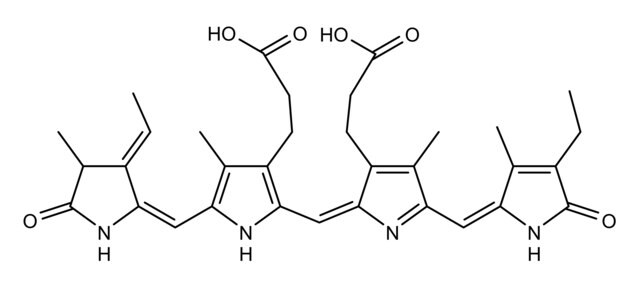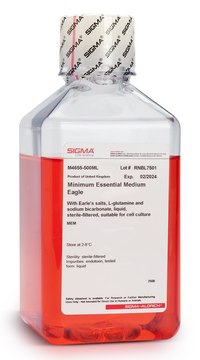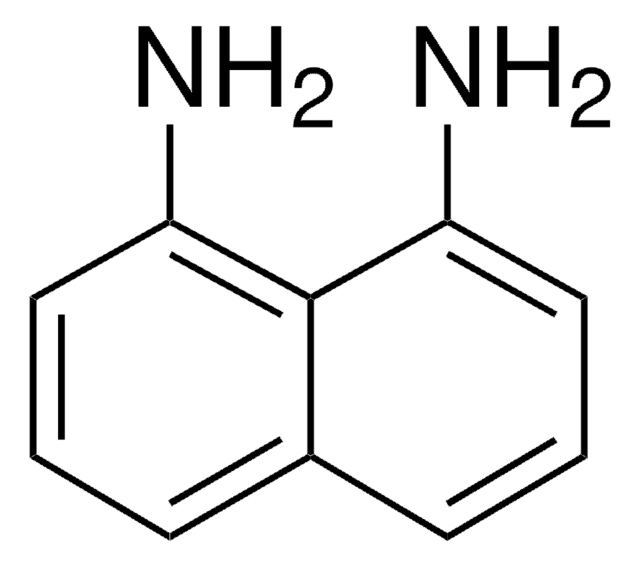R9532
Pyocyanin, Ready Made Solution from Pseudomonas aeruginosa
5 mg/mL in DMSO
동의어(들):
5-Methyl-1(5H)-phenazinone, Pyocyanine, Sanasin, Sanazin
로그인조직 및 계약 가격 보기
모든 사진(1)
About This Item
실험식(Hill 표기법):
C13H10N2O
CAS Number:
Molecular Weight:
210.23
MDL number:
UNSPSC 코드:
12352200
PubChem Substance ID:
NACRES:
NA.77
추천 제품
분석
≥98% (HPLC)
Quality Level
양식
DMSO solution
농도
5 mg/mL in DMSO
배송 상태
dry ice
저장 온도
−20°C
SMILES string
CN1c2ccccc2N=C3C(=O)C=CC=C13
InChI
1S/C13H10N2O/c1-15-10-6-3-2-5-9(10)14-13-11(15)7-4-8-12(13)16/h2-8H,1H3
InChI key
YNCMLFHHXWETLD-UHFFFAOYSA-N
일반 설명
Pyocyanin is a secondary metabolite, which is produced by Pseudomonas aeruginosa.
애플리케이션
Pyocyanin has been used:
- To disable the ability of forkhead box A2 (FOXA2) to regulate goblet cell hyperplasia and metaplasia (GCHM) and mucin expression.
- To activate nuclear factor (erythroid-derived 2)-like 2 (NRF2) through the reactive oxygen species (ROS)-inducible epidermal growth factor receptor (EGFR)-phosphoinositide 3-kinase (PI3K) cellular signal transduction pathway and its downstream effectors.
- To stimulate Pseudomonas aeruginosa PAO1 cell line adhesion and invasion in human lung carcinoma A549 cells via reactive oxygen species (ROS) production.
생화학적/생리학적 작용
Pyocyanin, a redox-active phenazine, is an electron receptor, which stimulates redox cycling in bacteria, liver cells, and human epithlial cell lines.
Pyocyanin, a redox-active phenazine, is an electron receptor, which stimulates redox cycling in bacteria, liver cells, and human epithlial cell lines. It enhances oxidative metabolism, which increases the formation of intracellular reactive oxygen species (ROS) via reduction of NADPH. Pyocyanin also increases the release of the neutrophil chemoattractant IL-8 by airway epithelial cells both in vitro and in vivo. This involves signal transduction pathways that include oxidants, protein tyrosin kinases and MAP-kinases. IL-8 secretion by these cells is in synergy with inflammatory cytokines. Pyocyanin accelerates neutrophil apoptosis in vitro. Mice infected with a pyocyanin-deficient strain of P. aeruginosa showed elevated levels of neutrophils and neutrophil chemokines and cytokines, as well as compromised bacterial clearance from the lungs compared with mice infected with a wild type strain. This suggests that pyocyanin production by P. aeruginosa suppresses the acute inflammatory response by pathogen-driven acceleration of neutrophil apoptosis and by reducing local inflammation, and that this is advantageous for bacterial survival.
Storage Class Code
10 - Combustible liquids
WGK
WGK 1
Flash Point (°F)
Not applicable
Flash Point (°C)
Not applicable
이미 열람한 고객
Pseudomonas aeruginosa pyocyanin activates NRF2-ARE-mediated transcriptional response via the ROS-EGFR-PI3K-AKT/MEK-ERK MAP kinase signaling in pulmonary epithelial cells
Xu Y, et al.
PLoS ONE, 8(8), e72528-e72528 (2013)
Nuclear protein HMGN2 attenuates pyocyanin-induced oxidative stress via Nrf2 signaling and inhibits Pseudomonas aeruginosa internalization in A549 cells
Liu K, et al.
Free Radical Biology & Medicine, 108(8), 404-417 (2017)
Pyocyanin-induced mucin production is associated with redox modification of FOXA2
Hao Y, et al.
Respiratory Research, 14(1), 82-82 (2013)
Theerthankar Das et al.
PloS one, 7(10), e46718-e46718 (2012-10-12)
Bacterial adhesion and biofilm formation are both dependent on the production of extracellular polymeric substances (EPS) mainly composed of polysaccharides, proteins, lipids, and extracellular DNA (eDNA). eDNA promotes biofilm establishment in a wide range of bacterial species. In Pseudomonas aeruginosa
Gee W Lau et al.
Trends in molecular medicine, 10(12), 599-606 (2004-11-30)
Pyocyanin (PCN) is a blue redox-active secondary metabolite that is produced by Pseudomonas aeruginosa. PCN is readily recovered in large quantities in sputum from patients with cystic fibrosis who are infected by P. aeruginosa. Despite in vitro studies demonstrating that
자사의 과학자팀은 생명 과학, 재료 과학, 화학 합성, 크로마토그래피, 분석 및 기타 많은 영역을 포함한 모든 과학 분야에 경험이 있습니다..
고객지원팀으로 연락바랍니다.









